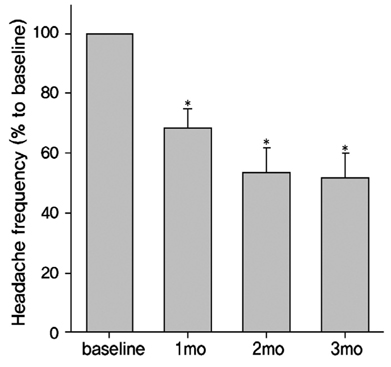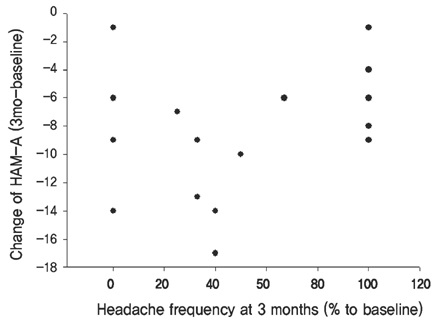J Clin Neurol.
2006 Dec;2(4):246-251. 10.3988/jcn.2006.2.4.246.
The Effect of Paroxetine on the Reduction of Migraine Frequency is Independent of Its Anxiolytic Effect
- Affiliations
-
- 1Department of Neurology, Seoul National University College of Medicine, South Korea. kimmanho@snu.ac.kr
- 2Department of Rehabilitation Medicine, Seoul National University College of Medicine, South Korea.
- 3Department of Neurology, Seoul Medical Center, Seoul, South Korea.
- KMID: 1980464
- DOI: http://doi.org/10.3988/jcn.2006.2.4.246
Abstract
- BACKGROUND AND PURPOSE
Anxiety is the most important precipitating factor of migraine attacks, and more than half of migraineurs have coexisting anxiety disorders. Paroxetine, an antidepressant, is one of the selective serotonin reuptake inhibitors (SSRIs) that has an anxiolytic effect, and is also known to be effective for migraine prophylaxis. The aim of this study was to determine the role of the anxiolytic effect of paroxetine on the prevention of migraine.
METHODS
This study investigated migraineurs with a general anxiety disorder who visited the neurological clinic. The following efficacy variables were assessed at baseline and after taking paroxetine (20 for 12 weeks: headache frequency, Hamilton Anxiety Rating Scale (HAM-A), Headache Management Self-Efficacy Scale (HMSE), and Headache Disability Inventory (HDI). The correlation between the headache responsiveness to paroxetine and improvement in anxiety levels was analyzed.
RESULTS
Twenty-four patients (aged 54.96+/-12.09 years, mean+/-SD) were included in this study. Paroxetine reduced headache frequency by 49.1% within 12 weeks (p<0.05 vs baseline). HAM-A and HMSE scores also showed an improvement, whereas there was no significant change in HDI score. The baseline HAM-A scores did not differ between paroxetine responders and nonresponders. In addition, the improvement in HAM-A score was not correlated with the reduction in headache frequency.
CONCLUSIONS
Paroxetine decreased the headache frequency and reduced anxiety levels. However, the anxiolytic effect of paroxetine was not correlated with the migraine prevention effect. These observation indicate that the anxiolytic effect of paroxetine does not contribute strongly to its prophylactic effect on migraine frequency in migraineurs with anxiety disorder.
Keyword
MeSH Terms
Figure
Reference
-
1. Breslau N, Rasmussen BK. The impact of migraine: Epidemiology, risk factors, and co-morbidities. Neurology. 2001. 56:S4–S12.
Article2. Wang SJ, Fuh JL, Young YH, Lu SR, Shia BC. Prevalence of migraine in Taipei, Taiwan: a population-based survey. Cephalalgia. 2000. 20:566–572.
Article3. Sakai F, Igarashi H. Prevalence of migraine in Japan: a nationwide survey. Cephalalgia. 1997. 17:15–22.4. Roh JK, Kim JS, Ahn YO. Epidemiologic and clinical characteristics of migraine and tension-type headache in Korea. Headache. 1998. 38:356–365.
Article5. Blau JN. Anxiety and depression in migraine. J R Soc Med. 1995. 88:59.6. Wacogne C, Lacoste JP, Guillibert E, Hugues FC, Le Jeunne C. Stress, anxiety, depression and migraine. Cephalalgia. 2003. 23:451–455.
Article7. Saper JR. Saper JR, editor. Migraine: precipitating factors. Headache Disorders. 1983. Boston: John Wright;33–48.8. Landy S, McGinnis J, Curlin D, Laizure SC. Selective serotonin reuptake inhibitors for migraine prophylaxis. Headache. 1999. 39:28–32.
Article9. d'Amato CC, Pizza V, Marmolo T, Giordano E, Alfano V, Nasta A. Fluoxetine for migraine prophylaxis: a double-blind trial. Headache. 1999. 39:716–719.10. Moja PL, Cusi C, Sterzi RR, Canepari C. Selective serotonin re-uptake inhibitors (SSRIs) for preventing migraine and tension-type headaches. Cochrane Database Syst Rev. 2005. CD002919.
Article11. Headache Classification Subcommittee of the International Headache Society. The International Classification of Headache Disorders: 2nd edition. Cephalalgia. 2004. 24:9–160.12. Hamilton M. The assessment of anxiety states by rating. Br J Med Psychol. 1959. 32:50–55.
Article13. Jacobson GP, Ramadan NM, Aggarwal SK, Newman CW. The Henry Ford Hospital Headache Disability Inventory (HDI). Neurology. 1994. 44:837–842.
Article14. Martin NJ, Holroyd KA, Rokicki LA. The Headache Self-Efficacy scale: adaptation to recurrent headaches. Headache. 1993. 33:244–248.
Article15. French DJ, Holroyd KA, Pinell C, Malinoski PT, O'Donnell F, Hill KR. Perceived self-efficacy and headache-related disability. Headache. 2000. 40:647–656.
Article16. Amery WK, Vandenbergh V. What can precipitating factors teach us about the pathogenesis of migraine? Headache. 1987. 27:146–150.
Article17. Breslau N, Davis CG, Andreski P. Migraine, psychiatric disorders, and suicide attempts: an epidemiologic study of young adults. Psychiatry Res. 1991. 37:11–23.
Article18. Merikangas KR, Angst J, Isler H. Migraine and psychopathology. Results of the Zurich cohort study of young adults. Arch Gen Psychiatry. 1990. 47:849–853.19. Lee ST, Park JH, Kim M. Efficacy of the 5-HT1A agonist, buspirone hydrochloride, in migraineurs with anxiety: a randomized, prospective, parallel group, double-blind, placebo-controlled study. Headache. 2005. 45:1004–1011.
Article20. Curran DA, Hinterberger H, Lance JW. Total plasma serotonin, 5-hydroxyindoleacetic acid and p-hydroxy-m-methoxymandelic acid excretion in normal and migrainous subjects. Brain. 1965. 88:997–1010.
Article21. Anthony M, Hinterberger H, Lance JW. Plasma serotonin in migraine and stress. Arch Neurol. 1967. 16:544–552.
Article22. Kimball RW, Friedman AP, Vallejo E. Effect of serotonin in migraine patients. Neurology. 1960. 10:107–111.
Article23. Hoyer D, Clarke DE, Fozard JR, Hartig PR, Martin GR, Mylecharane EJ, et al. International Union of Pharma cology classification of receptors for 5-hydroxytryptamine (Serotonin). Pharmacol Rev. 1994. 46:157–203.24. Brewerton TD, Murphy DL, Mueller EA, Jimerson DC. Induction of migrainelike headaches by the serotonin agonist m-chlorophenylpiperazine. Clin Pharmacol Ther. 1988. 43:605–609.
Article25. Fozard JR, Gray JA. 5-HT1c receptor activation: a key step in the initiation of migraine? Trends Pharmacol Sci. 1989. 10:307–309.
Article
- Full Text Links
- Actions
-
Cited
- CITED
-
- Close
- Share
- Similar articles
-
- Efficacy of Buspirone Hydrochloride in Migraineurs with Anxiety: a Randomized Double Blind, Parallel Group, Placebo-controlled Study
- A study on the therapeutic effects of Topiramate according to the types of migraine
- The Effect of Preventive Medication on the Improvement of Associated Symptoms in Pediatric Migraine
- Effect of Sleep Quality on Headache-Related Impact in Primary Headache Disorders
- Blockade of Kv1.5 by paroxetine, an antidepressant drug



